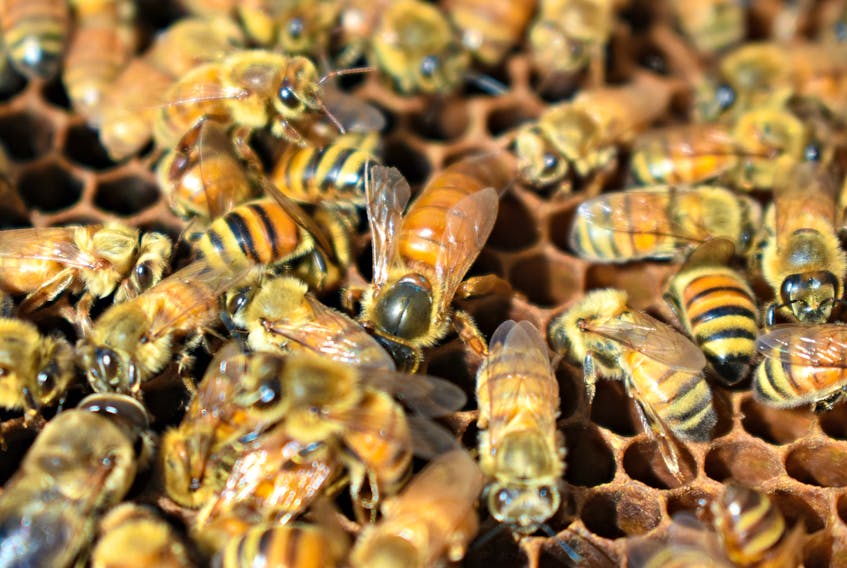A sweet, waxy smell rises as Troy Fraser smokes the bees out, removes the weighted frames of honey, and brushes the colony of workers and drones off while searching for the queen.
"In each honey bee hive, you have three castes of bees; one single queen, and then 95 per cent of the hive consists of worker bees, which are all females, and the last caste of bee is a male drone," explained Fraser, a second year P.E.I. hobby apiarist that has had an interest in bees ever since he was a child.
A drone's primary role is to mate with an unfertilized queen (the largest bee in the colony), and if they have not mated by fall, the hive goes into survival mode and the drones are kicked out.
"Unlike the worker bees, drones do not gather nectar or pollen and do not have stingers,” he says.
The average worker bee lives for five to six weeks and works without pause, producing around a twelfth of a teaspoon of honey.
Fraser has more than 40 hives in his one apiary surrounded by goldenrod, which despite being a weed, is a critical food source for late fall hives – and bees love it. Fraser said he is raising a nucleus colony of honeybees, centred on a queen, to winterize.
"I want to see how many survive winter to help replenish the production hives, which have gone into the local wild blueberries and helped pollinate."
‘Death by a thousand cuts’
What we eat is completely tied to the pollinators that cooperate with that species.
Provincial apiarist at P.E.I. Department of Agriculture and berry crop development officer Cameron Menzies says bees are a crucial component of ecosystem health.
"Wild blueberries are the most significant fruit export produced on P.E.I. Without the combined pollination that populations of native bees and managed honeybees provide, no fruit would be yielded."

Plants with heavier pollen that cannot be dispersed by the wind rely on bees to distribute, but bees face multiple threats.
"In my opinion, there are many factors for bee losses, and they struggle from various challenges every day. Varroa mites, small hive beetles, American foul-brood, and European foul-brood – all pests and diseases that can cause the colonies to collapse and or die," said Fraser.
According to Dr. Andrew Byers, a senior apiculturist and program lead for the Atlantic Tech Transfer Team for Apiculture, honeybees suffer death by a thousand cuts.
"Pesticides, Varroa (parasitic mites), other environmental pollutants, climate change seemingly bringing extremes of weather, emerging pests and diseases, the stress of migratory beekeeping practices for pollination," he listed the challenges honeybees face, as well as the beekeepers.
Menzies agrees with most experts that the worldwide spread of the Varroa 'Destructor' mite is the "number one threat to honeybees."
Varroa attacks and feeds on the honeybee, suppressing their immune systems, carrying deadly diseases, and creating pathways for other conditions to enter bee bodies.
"The Varroa mite is like a leech because it attaches itself onto the bee and sucks the blood out of it, and that's how the mite survives. But by doing so, they weaken the bee to the point not necessarily where it dies right away, but it cripples their immune system,” said Fraser, who checks his hives each day to make sure his honeybees are free from this mite.
"If untreated, the hive can go into winter and ultimately perish. Beekeepers spend a lot of time and money, making sure their bees are medicated going into winter and that the mite population in each hive is gone or minimized so the bees can survive."

Help protect bees
There are many ways – other than planting bee-friendly flowers – the public can help protect bees.
"Do not spray pesticides and support local beekeepers with purchasing honey. Even just allowing a beekeeper on your land to raise beehives will help because the bees will forage over a five-mile radius," said Fraser.
For native bees, people can help save threatened populations by providing a nesting habitat in their gardens.
"People can leave dried hollowed stems, piles of twigs, logs, and other woody debris on their property for these bees. They can even build a bee block using an untreated piece of lumber in which they several drill small holes for solitary bees to rear offspring within, or purchase 'bee hotels' for this purpose," Menzies said.
"Again, providing nesting habitat should be done in tandem with providing foraging resources (i.e. flowers) for the bees. As for honeybee habitat, since beekeepers manage them in wooden boxes, it is not applicable for the public to provide habitat. However, anyone can get into honey beekeeping either as a hobby or a commercial endeavour."

There are around 15 commercial beekeepers on P.E.I. who actively manage beehives for fruit crop pollination and or honey extraction, according to Menzies.
"There are likely at least twice as many other hobbyists or backyard beekeepers," he said.
P.E.I. has upwards of about 5,500 active honeybee colonies.
"Last winter was the best winter we've had in many years concerning hive losses. Only about 17 per cent of P.E.I. hives died over the winter, compared to around 50 per cent in previous winters. The weather in the early summer was ideal for honeybees as warm, sunny days are perfect for bees to pollinate and collect nectar to make honey," said Menzies.
But the recent lack of rainfall, according to Menzies, has caused a "nectar dearth" in which flowers stop producing as much nectar in response to the dry weather.
“It’s fair to say, we could do with the rain.”

Bees are more domesticated than they are wild, added Fraser, sadly because their natural habitat is disappearing.
"There is so much that goes into keeping bees alive for an apiarist such as making sure they are medicated, that pests don't weaken the bees before going into winter. As you gain more awareness of bees and information, you will be able to walk up to them and not get stung," he said.
"Bees have one purpose, and that is to survive by foraging from flower to flower. The last thing a bee wants to do is sting you because their stinger is a barbed hook, so if they sting, this hook gets stuck and pulls out their abdomen, and the bee will slowly die after. Stinging is a bee's last line of defence."
For those lacking confidence around bees, on National Honeybee Awareness Day, Aug. 15, it’s important to acknowledge that the honeybee is the most important single species of pollinator.
This insect ensures people and animals have the food they need to survive.










